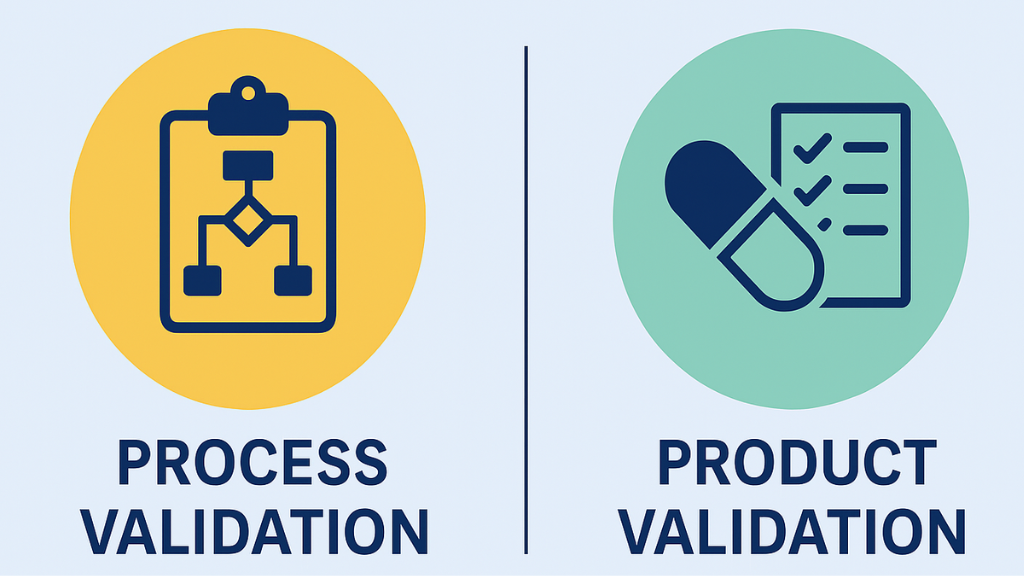
In the highly regulated pharmaceutical industry, product consistency, safety, and efficacy are essential pillars of quality assurance. One of the most critical aspects of ensuring this is validation—specifically, Process Validation and Product Validation. Though closely linked, these two concepts address different stages of pharmaceutical manufacturing. Understanding the Differences Between Process and Product Validation in Pharma helps manufacturers comply with Good Manufacturing Practices (GMP) and meet stringent regulatory requirements.
What is Process Validation?
Process Validation is a documented process that verifies a manufacturing process will consistently produce a product meeting its predetermined specifications and quality attributes. It is not just a regulatory requirement but a strategic approach to minimizing batch-to-batch variability.
Process Validation is typically divided into three key stages:
Process Design: This involves designing a robust manufacturing process based on development and R&D data. It includes defining critical process parameters and quality attributes.
Process Qualification: Here, equipment, facilities, utilities, and systems are evaluated to confirm their capability to perform consistently under commercial-scale conditions.
Continued Process Verification: After the commercial batch release, ongoing monitoring ensures the process remains in a state of control during routine production.
This systematic approach provides confidence in the manufacturing system. It ensures that production processes are repeatable and controlled, which ultimately helps in producing high-quality pharmaceutical products. Many of these validated processes directly contribute to the quality consistency of products offered on platforms like Innoglide Pharma Products.
What is Product Validation?
In contrast, Product Validation is centered on confirming that the final pharmaceutical product meets the intended use and requirements of safety, identity, strength, quality, and purity. It involves testing and analysis at different product development stages to ensure that the product performs as expected under real-world conditions.
Benefits of Product Validation include:
Minimization of Waste: Defective batches are identified before they reach consumers.
Cost Reduction: Prevents costly recalls by ensuring quality before release.
Regulatory Compliance: Satisfies FDA and other global health agency requirements.
Customer Trust: Ensures patients and healthcare professionals receive reliable and effective medications.
Key Differences: Process Validation vs. Product Validation
Although both forms of validation are intertwined, the key distinction lies in their focus:
Process Validation ensures that all stages of manufacturing consistently deliver the same quality output.
Product Validation assures that the finished drug meets all predefined criteria for its intended use.
Understanding the Differences Between Process and Product Validation in Pharma is critical for compliance and achieving high production efficiency. For example, a validated process might still yield an ineffective product if the validation doesn’t consider how the product will be used in real scenarios. Hence, validation efforts must bridge both process and product aspects.
Importance in GMP Compliance
Both validations are fundamental pillars of Good Manufacturing Practices. The FDA and other regulatory bodies emphasize that pharmaceutical companies must validate both their processes and products to ensure patient safety and treatment efficacy.
Process Validation: Encourages manufacturing consistency across different production sites.
Product Validation: Verifies that the end product works as intended for its medical purpose.
Incorporating both validations minimizes risk, optimizes product quality, and ensures that drug manufacturing complies with international standards.
Real-World Application
Let’s consider a hypothetical example: a company manufacturing a generic painkiller. The Process Validation will ensure that every batch contains uniform levels of active ingredients, is mixed at the right temperature, and compressed under appropriate conditions. Meanwhile, Product Validation will focus on ensuring the tablet dissolves properly in the stomach, delivers pain relief effectively, and has a shelf life as indicated on the label.
By implementing both forms of validation, manufacturers can reduce rework, avoid costly recalls, and maintain brand reputation. These steps are not just quality checks—they’re strategic business decisions with long-term profitability benefits.
International Guidelines
Global regulators such as the U.S. FDA, EMA, and WHO provide clear guidelines for validation practices. According to the FDA’s Process Validation: General Principles and Practices, process validation must be a lifecycle activity requiring ongoing evaluation.
For further reference, the detailed FDA guidelines can be reviewed at their official site, which provides comprehensive insights on current validation standards in pharmaceutical manufacturing.
Technological Advancements in Validation
The rise of digital tools and automation is transforming validation practices. Real-time monitoring systems, artificial intelligence, and data analytics now support continuous validation efforts. These tools make it easier to detect process deviations early, improve product traceability, and maintain data integrity.
Understanding the Differences Between Process and Product Validation in Pharma in this context is more relevant than ever, as companies invest in smarter systems to remain compliant and competitive in global markets.
#InnoglidePharma #PharmaceuticalValidation #ProcessValidation #ProductValidation #PharmaQuality #GMPCompliance #DrugManufacturing #QualityAssurance #PharmaIndustry #ValidationProcesses



